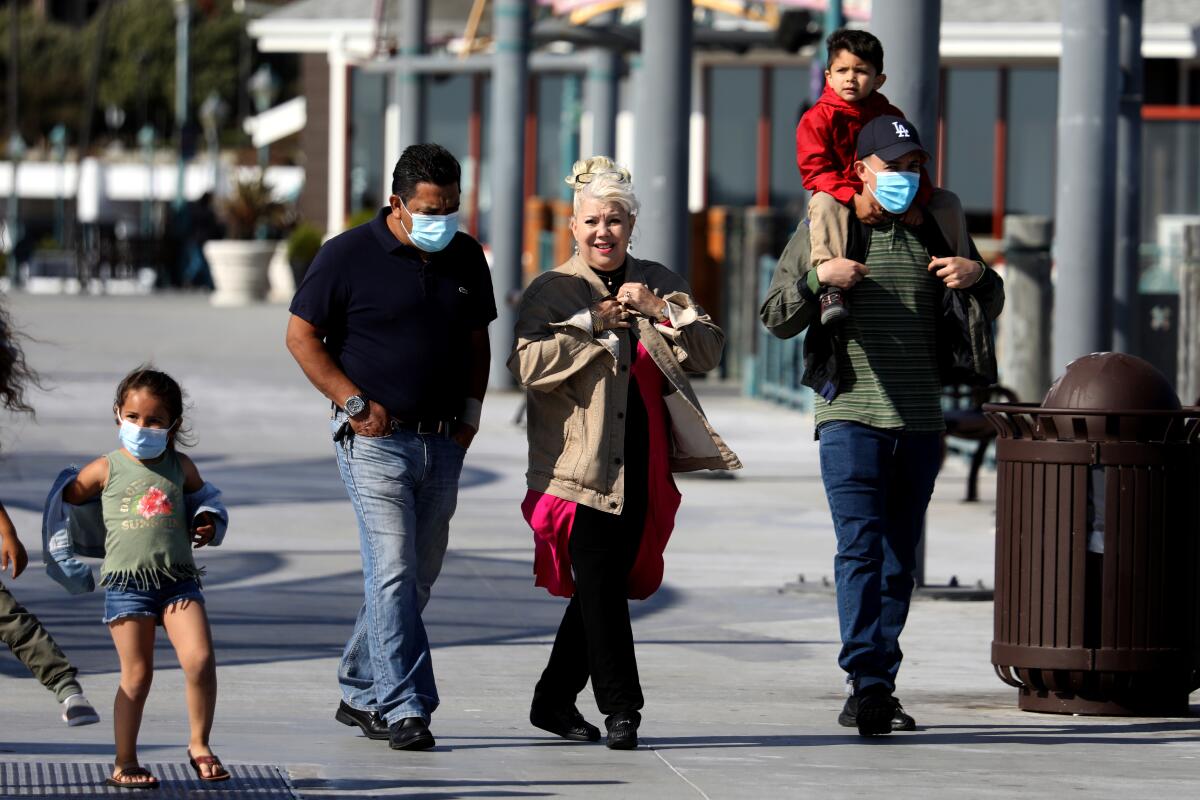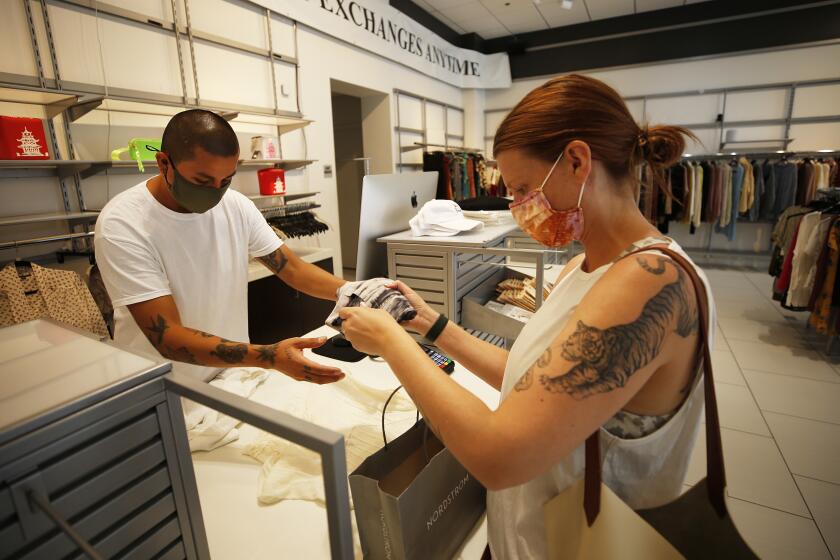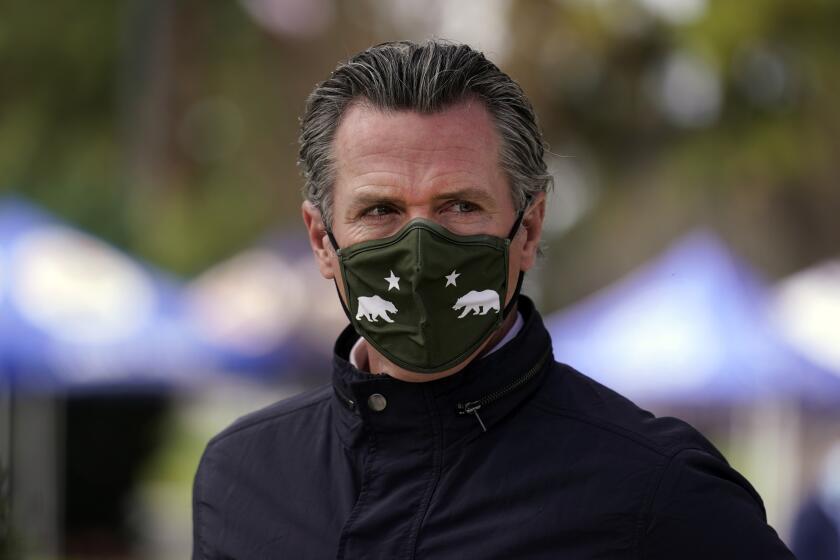What the CDC mask changes mean for travel, shopping, gatherings, outdoor life and more

In a momentous turn in the fight against COVID-19, federal officials are significantly easing mask guidelines as the threat of the pandemic rapidly fades. But officials in Los Angeles are asking people to refrain from pulling off their face coverings until the county and state have had a chance to review the recommendations.
“It’s really important for us not to jump the gun and create an unintended consequence where we’re creating risk where we didn’t need to,” L.A. County Public Health Director Barbara Ferrer said during a news briefing Thursday, noting that the Centers for Disease Control and Prevention’s announcement earlier in the day was not “implying that state and local regulations — especially those that protect workers — should be disregarded.”
One particular sticking point for the county is workplace requirements for mask wearing and social distancing, which differ from the CDC’s new recommendations.
While federal officials said anyone who is fully vaccinated can participate in indoor and outdoor activities, large or small, without wearing masks or physical distancing, L.A. County is asking that all residents continue to adhere to current local guidelines until the California Division of Occupational Safety and Health has had the opportunity to weigh in, which will not happen until at least next week.
The county cannot be less restrictive than the state, Ferrer said, noting that current California regulations require that everyone be fully masked and maintain six feet of distance at work sites, including grocery stores.
“In the interim, I do want to note that fully vaccinated people don’t need to wear a mask when they’re indoors around other fully vaccinated people, or when they’re outside in uncrowded areas,” she said. “However, when at businesses and in crowded venues — both indoors and outdoors — masks are still required to be worn by everyone.”
People who are fully vaccinated against COVID-19 no longer need to wear masks in most places, the CDC suggested. But in California, it may be a week or more before changes would be considered locally.
Here’s what the CDC recommended Thursday:
The basics
- Anyone who is fully vaccinated can participate in indoor and outdoor activities, large or small, without wearing a mask or physical distancing.
- Unvaccinated people or partially vaccinated people are still asked to wear masks in virtually all indoor settings and most outdoor settings when interacting with people from outside their household who may not be vaccinated. (Members of a single household of unvaccinated people can be maskless indoors if everyone else is vaccinated.)
- Masks are still required for everyone traveling on public transportation, including buses and trains, and in airports and stations.
- The rules also apply for hospitals, prisons, homeless facilities and other institutional settings.
- Local and state rules may be stricter and will remain in force.
- Unvaccinated people should still wear masks and get vaccinated right away.
The Centers for Disease Control and Prevention issued the following guidance:
Do’s and don’ts
Fully vaccinated people can:
- Resume activities without wearing masks or physically distancing, except where required by federal, state, local, tribal or territorial laws, rules and regulations, including local business and workplace guidance.
- Resume domestic travel, without having to get tested before or after travel or self-quarantine after travel.
- Forgo testing before leaving the United States for international travel (unless required by the destination) and forgo self-quarantine after arriving back in the U.S.
- Forgo testing after a known exposure, if asymptomatic, with some exceptions for specific settings.
- Forgo quarantine after a known exposure if asymptomatic.
- Forgo testing for routine screening if feasible.
For now, fully vaccinated people should continue to:
- Get tested if experiencing COVID-19 symptoms.
- Follow CDC and health department travel requirements and recommendations.
Travel
Domestic travel (within the United States or to a U.S. territory)
- Fully vaccinated travelers do not need to get a SARS-CoV-2 viral test before or after domestic travel, unless testing is required by local, state or territorial health authorities.
- Fully vaccinated travelers do not need to self-quarantine after domestic travel.
- For more information, see Domestic Travel During COVID-19.
International travel
- Fully vaccinated travelers do not need to get tested before leaving the United States unless required by their destination.
- Fully vaccinated air travelers coming to the United States from abroad, including U.S. citizens, are still required to have a negative SARS-CoV-2 viral test result or documentation of recovery from COVID-19 before they board a flight to the United States.
- International travelers arriving in the United States are still recommended to get a SARS-CoV-2 viral test three to five days after travel, regardless of vaccination status.
- Fully vaccinated travelers do not need to self-quarantine in the United States after international travel.
- For more information, see International Travel During COVID-19.
California could lift most COVID-19 mask requirements by June 15, Gov. Gavin Newsom said Wednesday.
In California
State officials have offered little new official guidance on masks this week, even as the nation’s top infectious disease expert, Dr. Anthony Fauci, said Sunday that “we do need to start being more liberal as we get more people vaccinated.”
California’s mask wearing orders were last updated on May 3, reflecting the latest CDC guidance at that time.
They generally require masks to be worn indoors whenever you’re outside your home, with certain exceptions, such as in situations outside a workplace setting when everyone indoors is vaccinated; or when there are only members of one unvaccinated household present, and all have a low risk of severe complications should they get sickened with COVID-19.
Under those state rules issued May 3, unvaccinated people must wear mask outdoors when they cannot stay more than six feet away from other people. Fully vaccinated people need to wear masks outdoors only in crowded settings, such as live performances, parades, fairs, festivals, sports events, or other similar settings.
Gov. Gavin Newsom on Wednesday said California could significantly ease its mask mandates in the coming weeks and noted that outdoor mask mandates could fall by the wayside as soon as June 15, when the state is slated to fully reopen its economy.
“They’ll be guidelines or recommendations,” he said of the outdoor masking rules, but noted that indoor activities — especially large convention events — may still have restrictions.
Ferrer said Thursday that the state and county will be reviewing the CDC’s recommendations shortly in order to “make sensible adjustments to the orders that are currently in place.”
“Because it’s still important to protect workers at all work sites, and all work sites must follow requirements set forth by the California division of Occupational Safety and Health, we ask that everyone continue to adhere to required distancing and masking at workplaces until Cal-OSHA changes these requirements.”
Dovetailing with the CDC’s recommendations, unvaccinated people are being asked to continue to wear face coverings, Ferrer said.
She also noted that the CDC guidelines were not released to the county health department ahead of time.
“We’re very supportive of the knowledge that the vaccines are highly protective, and that people who are fully vaccinated, really, in fact, don’t need to adhere to the same safety measures as those who are not fully vaccinated,” Ferrer said. “But it is that big question about making sure that as we’re doing this ... we don’t have an unintended consequence of creating more risk at a time when we’re really trying to move forward on the recovery journey.”
More to Read
Sign up for Essential California
The most important California stories and recommendations in your inbox every morning.
You may occasionally receive promotional content from the Los Angeles Times.














